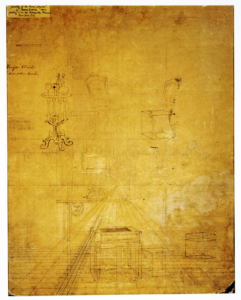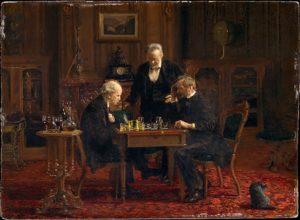Suppose you’re a painter, and you want capture a realistic scene of two men playing chess in a parlor. How would you do it? Most people, I think, would sit in the room and paint what they saw. Or, depending on their era, maybe they’d work from a photograph. A very meticulous artist might pencil out couple of single-point perspective lines to guide the recession of the room’s furniture. Vanishingly few artists would use a separate sheet of paper to create a 3-dimensional gridded space where everything in the room was geometrically plotted out with each object considered as its own individual study. But this is exactly what Thomas Eakins did.


There’s a decent chance your reaction is: Thomas Who? Eakins is an odd case, a man considered one of the leading American painters of the back half of the 19th century who has slowly slid into something that isn’t quite obscurity but is pretty far from household-name status. You’ve probably heard of the people considered his peers at the time: Winslow Homer, John Singer Sargent, James McNeil Whistler, (kinda) Mary Cassatt. A combination of scandals (Eakins was heavily involved in art education, and was involved in scandals revolving around nude models and students, and it’s a dense thicket that’s almost impossible to judge from 130 years out without getting lost in the gap between then-contemporary and current social mores; last time I looked, his wikipedia page was dominated by speculation about his sexual preference), changing tastes, and the random drift of history have shunted him off to the side. But in his day, Eakins was a big deal, renowned as a new kind of big-brained artist.
Eakins was a creature of his time. He worked during a period of unprecedented exuberance about the progress of science. He brought that spirit into his artistic practice, pursuing representational realism through a combination of techniques derived from science and mathematics. His approach was powerful but flawed, with inconsistencies that led to visual paradoxes; similar paradoxes lurked around the edges of the very science world that inspired him.
Eakins’ belief that perfect representation of reality could be attained in painting through advanced science-based technique was a manifestation of a mode of thought pervasive in late 19th-century American and European intellectual circles, an idea that science and knowledge had reached a summit. His social position in the academic elite of Philadelphia put him in contact with scientists, artists, and thinkers whose output presents a similarly teleological outlook. He basically soaked up their hubris. And this isn’t something I can claim to prove, but I’d guess that the passing of that particular scientific worldview has something to do with the slow drift of Eakins into semi-obscurity.
Continue reading THOMAS EAKINS, BRUSHING AGAINST THE LIMITS OF SCIENCE